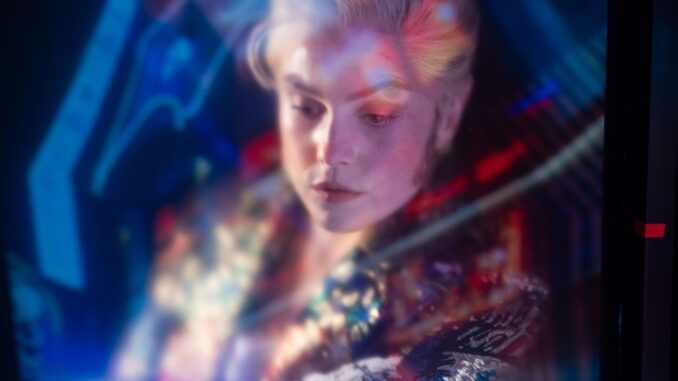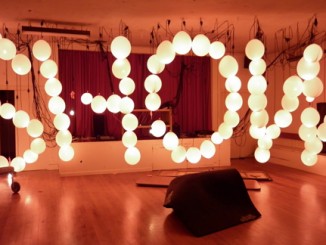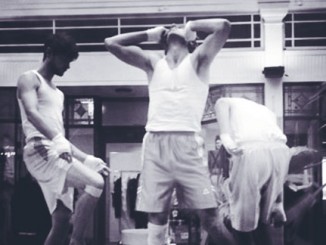
[Big Canvas]
Performed by actress Eryn Jean Norvill and constructed by a hardworking crew of camera-people (Babi Bertoldi, Zoltan Jonas, Sam Steinle, Josh Vellis, Sean Waite and Simon Croker) and technicians, The Picture of Dorian Gray is an epic, ambitious multimedia adaptation of Oscar Wilde’s novel.
Adapted and directed by Kip Williams, Dorian Gray is a maximalist experience – offering costume changes, split screens, and even some live superimpositions, combining pre-recorded footage of characters with the live performer.
Some of it feels like the show’s ambitions run amok, but as the story proceeds, and the title character becomes more detached from the world, that multiplicity of performance feels like Gray’s demons bubbling up to destroy him.
The use of multiple cameras onstage, filming Norvill from multiple angles, and projected on a variety of screens of various sizes (which move around the stage in various configurations) creates a multiplicity of images, fragmented collages of characters, piecing together a sense of the character’s interiority.
One of the show’s most unique aspects is its use of cinematic techniques and processes – particularly its use of the close-up. Formerly one of the major differences between the medium of theater and film, having a projection of Norvill’s face allows for more subtle performance choices, and produces an intimacy between the performer and the audience.
What also stands out about the production is its emphasis on camera movement over editing. Despite the number of screens, transitions and different environments, editing – cutting images together – is avoided (per my recollection). Editing is an inherently intellectual exercise – the juxtaposition of images are like numbers in an equation, which we put together to create new meaning. In comparison, camera movement, whether panning between characters or tilting up (or down) to register information, carries the potential for evoking emotional shifts, to suggest revelation, a shift in power, or mood or intention.
When these varied techniques work, the show is an epic meditation on the different roles people play, their internal conflicts, the blurry line between the private and public self, and the queer subtext underpinning Gray’s motivations and relationships (and one of the key examples of the show’s use of close-ups).
Central performer Eryn Jean Norvill manages a herculean task, not just in terms of juggling different characters (and costume changes), but in maintaining a style of performance that can work as a piece of live theater, while being able to register on camera without having to adjust for the increased scrutiny it allows.
I left the production fascinated by its construction, and watching its moving pieces come together. The video work (designed by David Bergman) is memorable, and collectively with lighting supervisor Nick Schlieper and composer-sound designer Clemence Williams, helps to maintain the atmosphere of the piece.
I cannot say I was moved by it.
There were a few points where it felt like the show was overtaken by its own form. Perhaps this is the result of watching so many shows made on the sniff of an oily rag, but there were times during the show where I felt like there was not enough left for the audience’s own imagination. There is so much use of screens, and footage of characters acting in other environments, that it starts to feel overwrought, and starts to impede the impact of Norvill’s performance.
It also feels a little too literal – by the dint of being a solo piece, the show is already being narrated. I almost wished the show became smaller as it went along, becoming more detached from real props and sets.
The people I went with enjoyed it, and I did not hate the experience, but I did leave questioning the effect of the production’s ambition on the text. At the very least, as a merging of different media forms and languages, it is a text worth experiencing.
The Picture of Dorian Gray plays Kiri Te Kanawa Theatre, Aotea Centre 18th to the 25th of March 2023 as part of the Auckland Arts Festival.




Leave a Reply